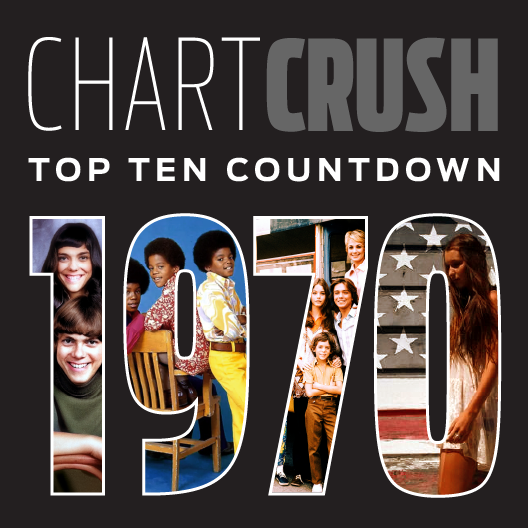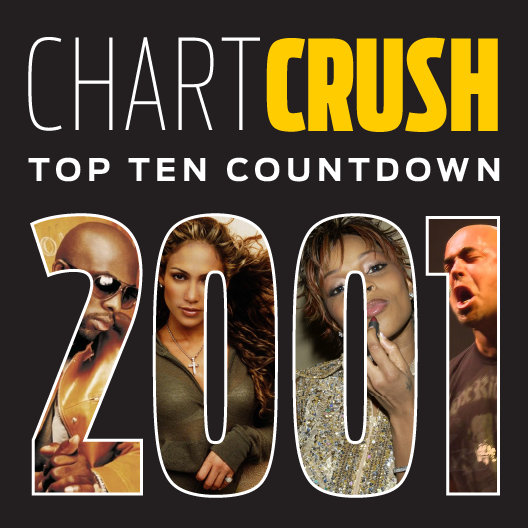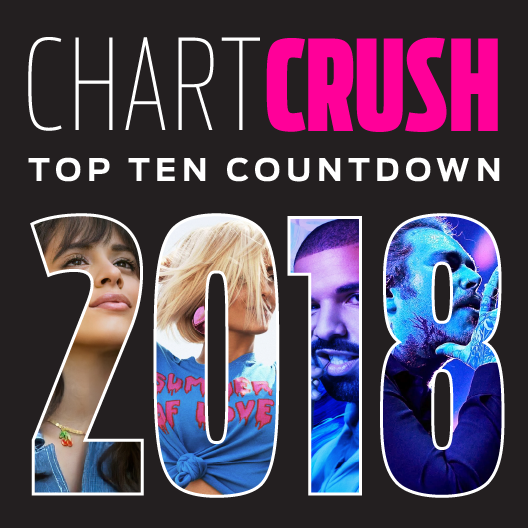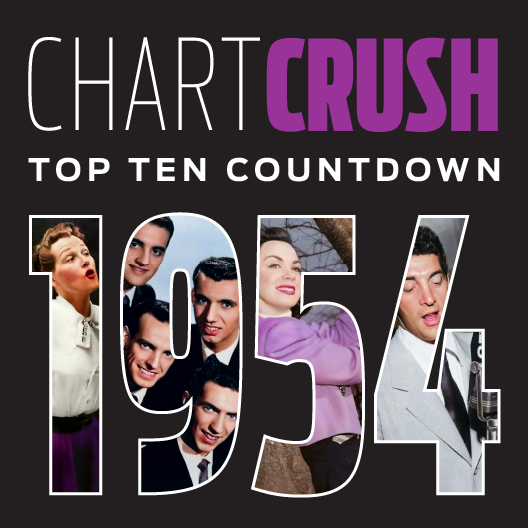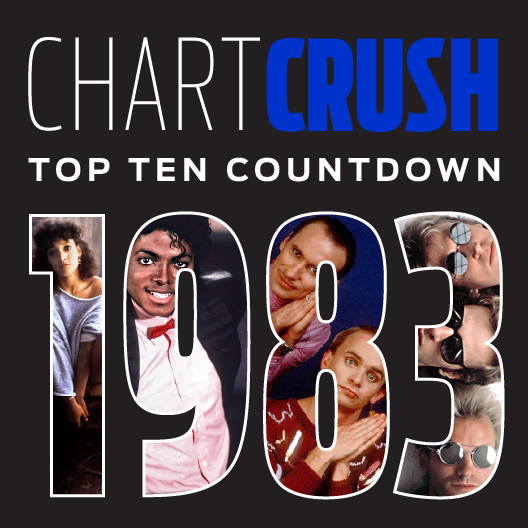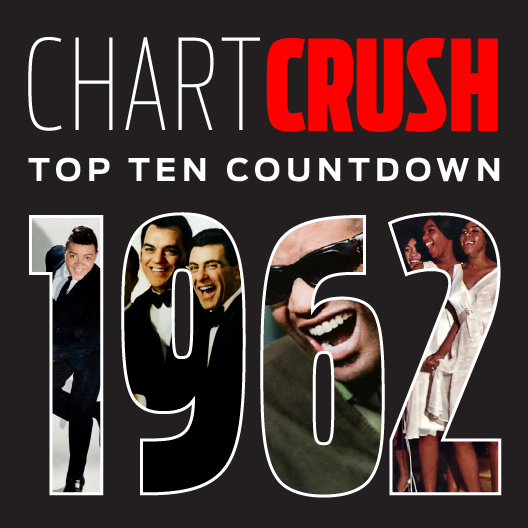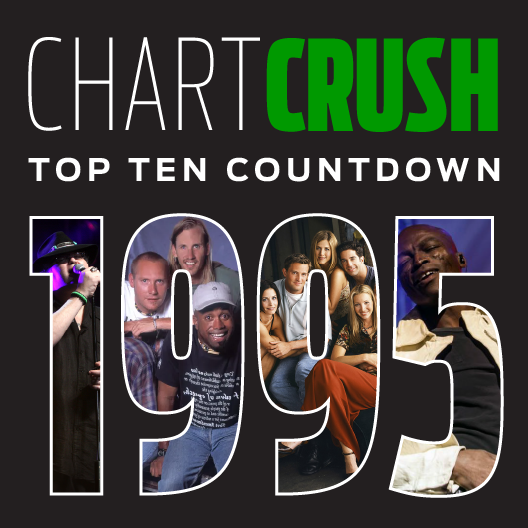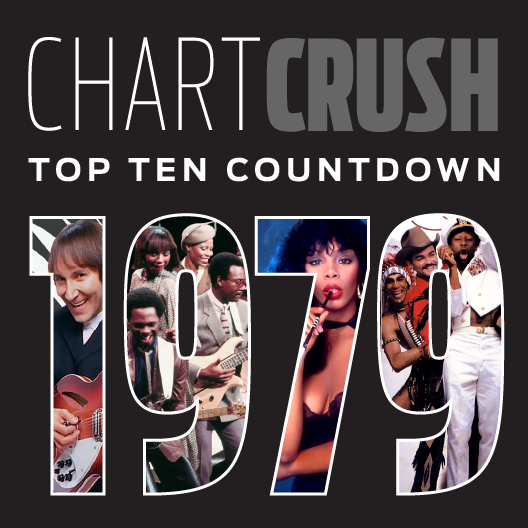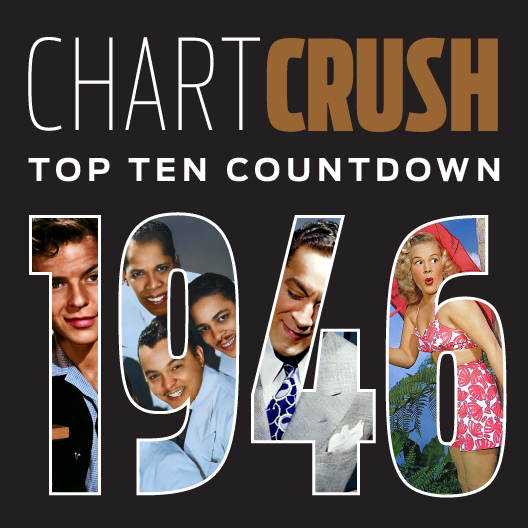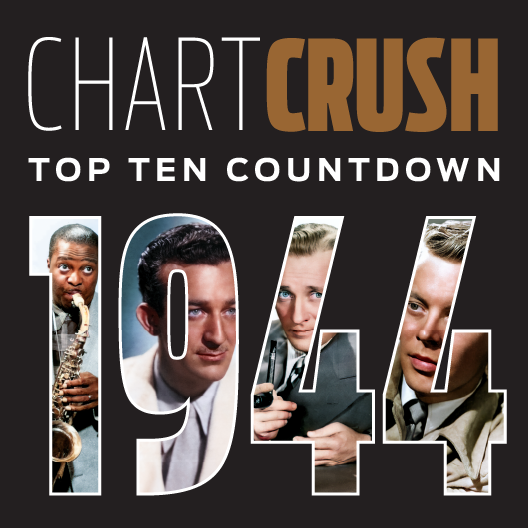
1944 Top Ten Pop Countdown Podcast
It’s Bing Crosby’s best year ever and Louis Jordan is the jukebox king as Decca and Capitol settle with the musicians union and get a clear shot at the charts.
::start transcript::
Welcome to the Chartcrush Top Ten Countdown Show, I’m your host, Christopher Verdesi. Every week we do a deep dive into a year in Pop music and culture and count down the top 10 records according to our recap of the weekly charts published at the time in Billboard, the music industry’s top trade mag.
This week on Chartcrush, we’re counting down 1944, the year America and its Allies turned the tide in World War II as the Soviets took back most of their own territory lost to the Nazis in ’41 and ’42, and the massive D-Day invasion of occupied France, June 6, opened up a second European front. And in the Pacific, by Fall, bombers were within range of Japan itself after the U.S. retook Guam and the Mariana and Palau Islands, and General MacArthur kept his promise to return to the Philippines.
No, the War wasn’t over yet, but by the end of 1944, victory was in sight. In New Mexico, J. Robert Oppenheimer and his team were busy cracking the code on the atomic bomb in the top-secret Manhattan Project.
Monumental times, but did you know that for most of World War II, ’42 to ’44, record labels couldn’t record musicians? Yeah, the musicians’ union was on strike! Crazy, right? American Federation of Musicians boss James C. Petrillo thought records and jukeboxes were gonna replace live entertainment and put musicians out of work.
Of course, that zero-sum-type reasoning, faulty on almost every level in a market economy; in music, records, radio and concerts reinforce each other so all the channels benefit. But the U.S. didn’t really have a market economy during the War with Feds controlling prices and wages and rationing almost everything.
Even after the National War Labor Board ruled against the AFM and President Roosevelt personally reached out asking Petrillo to cut it out because, c’mon, people gotta have their tunes in a War!, the strike continued for two years, until labels, one by one, agreed to cut musicians in on profits and pay performance royalties.
Petrillo did make one concession a year in to the strike: union members could record V-Discs for overseas troops, “V” for “victory. Strictly export-only, though; labels had to destroy the masters. So with the strike, live on the radio was the only way to hear the latest tunes. That, or going out. But after Pearl Harbor, Bands were losing players to enlistments and the draft, and once those Wartime shortages and rationing kicked in on things like gas, rubber for tires and other touring essentials, taking a 15- or 20-piece Band out on the road became a logistical nightmare.
And besides, cities had blackout restrictions so enemy bombers, ships and submarines couldn’t see targets at night. So it was literally lights out on the most vibrant Dance Club scene ’til Disco in the late ’70s.
The biggest of the Big Bandleaders, Glenn Miller, was clearing nearly $400 grand a week inflation adjusted, but just before the recording ban, he lobbied for a Captain’s commission to lead the Army Air Forces Band, and did that until his plane crashed over the English channel in late ’44.
Other Bands soldiered on best they could, but in L.A. Stan Kenton’s Orchestra was pushing the boundaries of what Swing Jazz even was, with a musically ambitious approach meant more for listening than for dancing. And once his label, the L.A.-based startup Capitol, settled up with Petrillo in October of ’43, Kenton’s records were national hits and inspired other Jazz players to branch out and get creative, which led to Be-Bop, Progressive Jazz and the end of Swing as America’s dominant Pop music by the end of the War.
Congress’ hefty Cabaret Tax on dancing establishments in ’44 was another nail in the coffin, and it stayed in effect all the way ’til 1965, long after America’s ballrooms had been converted to warehouses and bowling alleys.
#10 Bing Crosby – San Fernando Valley
Now Capitol wasn’t the first or biggest label to settle with the union and resume recording in ’43; Decca was, in September, so 59 of 1944’s top100 hits are on just that one label, Decca. They didn’t have as many Bands as other labels but they had the top Crooner going back to the early ’30s, and ’44 was his biggest year yet, with 11 of those 59 records. Kicking off our Chartcrush countdown of 1944’s biggest hits at #10 it’s Bing Crosby with “San Fernando Valley.”
Ah, the San Fernando Valley, Southern California’s sprawling suburb north of L.A. Folks had already started moving there in the ’30s but it was still pretty idyllic with its apricot and walnut orchards and citrus groves: an Earthly paradise to fire hopes and aspirations amid shortages, rationing and deprivation.
Unfortunately, after the War a few too many people took Bing Crosby’s advice and made the San Fernando Valley their home; the population quintupled from ’45 to ’60. We’ll be hearing from Crosby again here on our Chartcrush Top Ten Countdown for 1944.
#9 Martha Tilton – I’ll Walk Alone
But at #9, we have Capitol’s biggest hit of the year, the West Coast startup label that came to terms with Petrillo and the AFM in October of ’43, a month after Decca. The song by Jule Styne and Lyricist Sammy Cahn was in Universal’s all-star morale boost musical Follow the Boys and two different versions of it are among the top 10 records of ’44. That wasn’t uncommon in the ’40s when acts rarely wrote their own songs. Instead pro Songwriters wrote them, Publishers published them, and multiple labels scrambled to record versions with their artists under contract. Broadway and movies, the top source for hit songs.
It’s one of the many hits from the War years in which a gal reassures her lover fighting overseas that she’ll stay true to him. The version by the Singer who does it in the movie was the bigger hit even though this one hit the charts first and has musicians playing on it! More on that when we hear that other one later, but at #9, Martha Tilton’s version of “I’ll Walk Alone.”
“Liltin'” Martha Tilton first got known singing with Benny Goodman’s Band in the late ’30: the first Big Band to play Carnegie Hall. That was in ’38, and then she was the Singer on Goodman’s big 1939 hit, “And the Angels Sing.” That song, co-written by lyricist Johnny Mercer, and it was Mercer who signed Tilton as a solo act to the new label he was starting, Capitol Records.
Capitol’s very first recording session in the Spring of ’42 just a few months before the strike, was Tilton’s “Moon Dreams,” which wasn’t a hit, but “I’ll Walk Alone” sure was, especially on Armed Forces Radio’s 400 stations around the globe: estimated audience, 50 million-plus soldiers and civilians. Too bad Billboard wasn’t charting that.
Their Airplay charts have never included stations outside the United States, but before 1945, we can’t factor Airplay into our record rankings at all because the Airplay chart was only an alphabetical listing of song titles, not broken out by the different versions out on records.
Publishers needed to see “Radio Plugs” which included live on-air performances bundled together by title for royalty purposes. If Martha Tilton’s “I’ll Walk Alone” was bigger on Radio than the version still to come in our Chartcrush 1944 countdown that sold better and got more Jukebox plays, we’ll never know.
Tilton toured throughout the War in Comedian Jack Benny’s USO package, but unlike other Female Singers who became Pop icons in those years like Doris Day, Dinah Shore and Kitty Kallen, she didn’t score any big hits after the War.
#8 Louis Jordan and His Tympany Five – G.I. Jive
Sticking with Capitol for our #8 hit here on our Chartcrush Top Ten Countdown for 1944, we have another song from Follow the Boys, the movie “I’ll Walk Alone” was in, but here it’s the same artist who does it in the film, a Vocalist/Saxman/Bandleader who with this record became the first big R&B/Pop crossover act in chart history. “Father of R&B,” just one of the many titles he’s earned over the years.
Billboard started charting what it later renamed “Rhythm & Blues” in 1942 on its weekly “Harlem Hit Parade” top 10 record sales ranking, and he’d already notched five hits on that by ’44, but then in August of ’44, this one topped the Pop Jukebox chart for two weeks as well, and cracked the top 5 on Pop Best Sellers.
“King of the Jukebox,” another name he earned. At #8, Louis Jordan & His Tympany Five, doing a Johnny Mercer song (there’s that name again), “G.I. Jive.”
Louis Jordan’s “G.I. Jive,” #8 on our Chartcrush Countdown of 1944’s top 10 Pop hits. Johnny Mercer’s own version of his clever light-hearted send-up of military life was also out backed by Capitol’s long-time House Orchestra led by Paul Weston, and it also scraped the charts, but Jordan’s blew it away, especially as I mentioned on the Jukebox chart, which was brand new in ’44: Billboard‘s ranking of records from a national weekly survey of jukebox operators.
It cost a nickel to play a song on a jukebox in the ’40s, roughly 90 cents in today’s money, and when operators went to collect the coins and switch out the records, they saw what tunes were being played and how often from the mechanical tallies on the machines.
Nearly a half million jukeboxes in America in 1944, so the chart was a key milestone, and rather than just fall back on Best Sellers like nearly every other source that ranks pre-Hot100 hits, our Chartcrush rankings are based on a combined weekly chart derived from all the available weekly Pop charts: Sales, Jukeboxes and (starting in ’45), radio DJ spins, with equal weight for each. And from that we can use the exact same algorithm to rank the year as we do for years after Billboard did its own chart consolidation in 1958 with the Hot100.
By the way, the flip-side of Louis Jordan’s “G.I. Jive” was also a massive Jukebox hit, #2 for three weeks in September: “Is You Is or Is You Ain’t (Ma’ Baby).” Jordan scored over three times as many R&B #1’s in the ’40s as his closest competitors on that chart, 17, and another nine Pop crossover hits. “Father of R&B” indeed!
#7 Bing Crosby – I’ll Be Seeing You
OK, at #7 is another wistful ballad that found huge resonance during the War, its message of love and connection transcending separation, loss, time and distance, applicable not just to lovers, but to mothers, sons and daughters and of course the soldiers themselves overseas. But the song was written before the war, for a 1938 Broadway flop called Right This Way, which the song’s Lyricist Irving Kahal joked was the answer to the only question on people’s minds in the theater: “Where’s the exit?” Right this Way! Here again, Bing Crosby, the biggest, but not the only hit version of “I’ll Be Seeing You.”
Bing Crosby, “I’ll Be Seeing You” at #7 on our 1944 edition of the Chartcrush Top Ten Countdown Show. Tragically, Irving Kahal didn’t live to see what he considered his best song become a hit. He died of a heart attack the year before in ’43 at just 38. But he did get to hear a 1940 version that was also a hit when Victor reissued it in ’44. The Tommy Dorsey Band’s with Frank Sinatra singing was on the charts 17 of the 24 weeks that Bing’s new version on Decca was.
Again, Bing’s label Decca could record at the end of ’43, but Victor and Columbia’s staring contest with Mr. Petrillo continued all the way to the end of ’44. They were able to hold out a little longer not just because they were the biggest record labels, but both also had deep-pocketed parent companies whose main business was radio: RCA with its NBC network was Victor’s; CBS was Columbia’s.
#6 Glen Gray and His Casa Loma Orchestra (vocal Eugenie Baird) – My Heart Tells Me (Should I Believe My Heart?)
At #6, a Band that’d had been around since the late ’20s and named themselves after a converted castle in Toronto where they played for eight months, and kept on using the name even after the place was seized by tax authorities and shut down at the start of the Depression.
By the Summer of ’33 they’d landed at the Glen Island Casino Resort north of New York City where they carved out a sweet spot between the swanky Dance music that was the default at such places, and the new Swing Jazz erupting out of Harlem. And CBS was beaming those performances out to a national network audience on their Camel Caravan broadcast a year before anyone had even heard of Benny Goodman, so the band gets a lot of the credit for taking Swing music mainstream. But the Bands that came to define the sound eclipsed them once it exploded later in the ’30s.
Still, they kept going and in ’44, this was the closest approximation on a record to Pinup and box office Queen Betty Grable’s performance of the song in the Technicolor musical Sweet Rosie O’Grady (Grable didn’t make records). At #6 it’s Glen Gray’s Casa Loma Orchestra featuring their new Girl Singer Eugenie Baird, “My Heart Tells Me.”
Glen Gray and the Casa Loma Orchestra with Eugenie Baird, “My Heart Tells Me” at #6, another Decca release that had a clear shot at the charts after the label was the first to come to terms with the musicians’ union and could record again.
For years, the Casa Lomans were a collective of talented players with no official leader, but Glen Gray took the conductor’s baton by acclamation in 1937 and by ’44 he’d trademarked the name, and Glen Gray and the Casa Loma Orchestra continued performing and releasing singles and albums on and off until Gray died in 1963.
#5 Dinah Shore – I’ll Walk Alone
At #5 we have the bigger of the two versions of the song we heard at #9 by Martha Tilton, and the only record on Victor in our countdown. Victor and Columbia, again, the longest holdouts in the two-year-plus Petrillo musicians’ strike. Labels had to get creative once their vaults ran dry. I mentioned Victor’s re-issue of their 1940 Tommy Dorsey/Frank Sinatra version of “I’ll Be Seeing You” after Bing Crosby’s new one on Decca was a hit. That worked out well, but another loophole, since Singers weren’t even in the union, labels could record a capella records.
Well once Bing Crosby’s “Sunday, Monday or Always” with the Ken Darby Singers and no Band hit #1 in the Fall of ’43, Vocal Groups were suddenly in high demand, both as standalone recording acts, and to back name Singers on records instead of Bands. And our #5 song was the last one of those that was a big hit, ironically right as Victor and Columbia were agreeing to Petrillo’s demands and getting Bands back in their studios.
Now movie studios weren’t affected by the strike, just record labels, so the version of the song in the film Follow the Boys by the same Singer has Orchestra backing, but for the record, she’s backed by an unnamed Mixed Chorus, and it handily beat Martha Tilton’s version of the song on Capitol even though that one as we heard back at #9, had an Orchestra! At #5, Dinah Shore’s version of “I’ll Walk Alone.”
Dinah Shore’s voice was too delicate for Big Bands, but she scored her first top 10 as a solo act in 1941, over two years before Frank Sinatra split from Tommy Dorsey and scored his first solo hits in ’43. By the way, those were also a capella records backed by Vocal Groups, just like Dinah’s version of “I’ll Walk Alone” we just heard at #5 here on our 1944 edition of the Chartcrush Top Ten Countdown Show.
Her only hit in ’44, but things picked up again and when you add it all up, she was the ’40s decade’s top charting Solo Female.
“I’ll Walk Alone,” the song, had another big burst on the charts in 1952 after it was in the biopic With a Song in My Heart about Singer Jane Froman, who was crippled in a plane crash in Europe during the War. Froman’s own ’40s-sounding version charted, but ’52 was peak Crooner, so belter Don Cornell’s was the bigger hit.
#4 Jimmy Dorsey & His Orchestra (vocal Kitty Kallen) – Besame Mucho
At #4, yet another song introduced by Follow the Boys, the movie that also had Louis Jordan’s “G.I. Jive,” and Dinah Shore doing “I’ll Walk Alone.” It’s a Mexican bolero written in the early ’30s and in the movie it’s an instrumental done by Charlie Spivak and His Band, but three vocal versions made the charts in the Spring of ’44 and this one was #1 for seven weeks.
Most of the top Big Bands were on Victor or Columbia and couldn’t record due to the strike, but these guys were on Decca and could: the label’s only A-list Big Band before the strike, so of course no other Band came close on the charts in ’44: five top 10s during the year. It’s Jimmy Dorsey & Orchestra with a vocal duet—they were known for those—with longtime Male Singer Bob Eberly and newcomer Kitty Kallen, the first hit version of “Besame Mucho.”
“Besame Mucho,” Spanish for “Kiss Me a Lot.” The Beatles did it in their early sets in ’62 with Paul McCartney singing but the original hit was the one we just heard at #4 here on our 1944 edition of the Chartcrush Top Ten Countdown Show: Jimmy Dorsey & Orchestra with Kitty Kallen, who’d just replaced newlywed Helen O’Connell as Bob Eberly’s duet partner.
Although two of Dorsey’s hits in ’44 had just Kallen on vocals, after Eberly got drafted, Kallen jumped ship for Trumpeter Harry James’ Band and had a big, big year in ’45 with seven chart hits including two that no Second World War Victory playlist would be complete without: “I’m Beginning to See the Light” and “It’s Been a Long, Long Time.”
#3 Harry James & His Orchestra (vocal Dick Haymes) – I’ll Get By (As Long as I Have You)
Harry James’ Band had been on a hot streak before the strike too, and in ’43 James got hitched to the Pinup movie star I mentioned earlier, Betty Grable, which made him even more famous, and two sides he and his Band recorded not just before the strike, but before the War were #1 hits in ’43 and ’44. In ’43 it was a reissue of “All or Nothing at All” sung by Frank Sinatra in 1939, which first came out in 1940 before either were superstars, but on the reissue, Columbia swapped the credits to make Sinatra the headliner since they’d just signed him up as a solo act.
And in ’44 Columbia scored big with a previously unreleased side with the Argentinian immigrant Singer who’d replaced Sinatra in the Harry James Band. He’d gone solo too during the strike and landed four a capella smashes in a row, all between July and November ’43, but for Decca, not Columbia, so Harry James got to keep his headliner status on that record. And those four a capella hits in ’43 were as big as the five of those that Sinatra did for Columbia at the same time. At #3 it’s Harry James & Orchestra featuring Dick Haymes, recorded in 1941, “I’ll Get by (As Long as I Have You).”
#1 the week the Allies’ turned the tide against the Nazis in Europe with the massive D-Day Invasion of occupied France, June 6, Harry James with Singer Dick Haymes “I’ll Get By,” #3 on our Chartcrush Top Ten Countdown of 1944’s top 10 hits. Yet another song featured in that all-star musical Follow the Boys, sung in the movie by Dinah Shore.
Harry James was classified 4-F ineligible for military service due to an old back injury, but still went for a second Army physical in ’44 and even dissolved his Band thinking he was about to go fight, but the draft board reaffirmed his 4-F status. Dick Haymes on the other hand was accused in print of dodging the draft by claiming nonbelligerent status as a citizen of neutral Argentina, but the draft board too classified him 4-F for hypertension.
By the way, Frank Sinatra didn’t serve either: 4-F for a perforated eardrum, but Army files that later came to light said it was because of emotional instability!
#2 Mills Brothers – You Always Hurt the One You Love
Now besides a capella, another way for labels to get around the musicians strike was to record a Singer accompanying him or herself on a simple instrument like a guitar or piano. Now post-1965 or so, that’d be a loophole big enough to drive a truck through, right? But in the ’40s that was unheard of in Pop, even rarer than Singers who wrote their own material.
Blues and Country, different story, but those primitive musical ghettoes were worlds apart from the glitz, glamor and sophistication of the society resorts and swanky hotel ballrooms where “real” musicians and Singers entertained genteel audiences. Blues and Country records sounded raw and crude, down ‘n dirty, like the folks who made ’em and the folks who bought ’em, and no one was trying to change that.
But our Black Vocal Group at #2 had perfected a smooth, sensitive style heading into the ’40s after spending the ’30s scatting and beat-boxing on Novelty records. Very successfully, I might add, but the musicians’ strike gave them their shot at mainstream Pop glory, and they hit the bullseye, first with “Paper Doll,” the #1 song of 1943, and then nearly repeating at #1 on the year in ’44 with another record that was just vocals and guitar nearly a year after Decca could record full Bands again.
14 weeks in the top 5 on both the Best-Sellers and Jukebox charts, August to December and the #2 hit of 1944, it’s The Mills Brothers’ “You Always Hurt the One You Love.”
Another Black Vocal Group, The Ink Spots, had hit big in ’39, and inspired The Mills Brothers to hone the ultra-smooth Vocal harmony sound they unleashed on “Paper Doll” in ’43, then “You Always Hurt the One You Love,” #2 here on our Chartcrush Top Ten Countdown for 1944.
Incidentally, the Ink Spots? Also still going strong in ’44 with their two top 5’s during the year, “I’ll Get by (As Long as I Have You)” and “Into Each Life Some Rain Must Fall” with Ella Fitzgerald.
#1 Bing Crosby – Swinging on a Star
Now I just got done telling you a minute ago how rare it was for Singers to write their own Pop songs in the ’40s, and it’s true: songwriting was for Songwriters; Singing was for Singers, and instruments, as Petrillo was constantly reminding everyone, were for musicians in the American Federation of Musicians. But the idea for our #1 song came from something the Singer said to his cranky 10-year-old son at a brainstorming dinner at his home with one of the Songwriters: “If you don’t go to school, you might grow up to be a mule.”
Well, Songwriter Jimmy Van Heusen liked that line so much that he took it to his partner Johnny Burke, and the resulting song, sung by the Singer who’d inspired it, was #1 on both Sales and Jukeboxes seven weeks mid-August to the end of September. We’ve already heard from him twice this hour; at #1, from his 1944 movie Going My Way, Bing Crosby with the year’s Oscar-winning Original Song, “Swinging on a Star.”
Bing Crosby’s “Swinging on a Star,” the #1 song here on our 1944 edition of the Chartcrush Top Ten Countdown Show. Close harmony backing courtesy of The Williams Brothers, one of whom was 17-year old Andy Williams, who went on to notch seven top 10s from 1956 to ’63 and sings the streaming-era holiday perennial, “It’s the Most Wonderful Time of the Year.”
Also worth noting: even though Decca was no longer subject to the Recording Ban, they had a Vocal Group backing Bing on that record anyway, in addition to the Band, and that close-harmony Vocal sound that got popular during the strike persisted on Pop hits for years.
Bonus
So there you have them: the top ten records of 1944 according to our exclusive Chartcrush ranking we derived by combining Billboard‘s published weekly Sales and Jukebox charts into a single weekly chart, then ranking the year same as we do for every year including after the Hot100 debuted in 1958.
But in years like 1944, when multiple versions of songs charted, if you’re only looking at records you’re gonna miss songs that when you add up all the versions that charted, were among the year’s top 10 hits even if no one version was dominant enough to be in the top 10 records. Six of the top 10 songs of ’44 did have versions in the top 10 records and “I’ll Walk Alone” had two, but that leaves four that we didn’t hear a version of in our countdown, so in the time we have left we’re gonna go through those.
#13 Guy Lombardo – It’s Love-Love-Love
The #10 song of 1944 combining both of its versions that made the charts was a light-hearted romp from a movie called Stars on Parade that hit in the Spring of ’44 offering a definition of “love” for a generation about to celebrate its World War 2 victory and get on with the business of settling down and raising families.
The Four King Sisters had a strike-compliant a capella version out on Victor’s Bluebird subsidiary. That’s #46 on our ranking for 1944. But Guy Lombardo and His Royal Canadians’ version shakes out at #13. On Decca, featuring former Glenn Miller Band Singer Skip Nelson, “It’s Love-Love-Love.”
“The Sweetest Music This Side of Heaven,” as the Chicago Tribune described Guy Lombardo & The Royal Canadians in 1928. Had there been charts before 1940, “It’s Love-Love-Love” would’ve been something like their 22nd #1.
By ’44 they were five years in to their 33-year residency at The Grill Room in New York’s Roosevelt Hotel, where their New Years Eve performances became iconic. The party moved to the Waldorf-Astoria Hotel in the early ’60s and continued until 1976, the year before Guy Lombardo passed away and Dick Clark became the new showbiz face of New Years. The Lombardo Band’s version of “Auld Lang Syne,” though, still to this day the first thing you hear after the ball drops in Times Square.
#20 Louis Jordan and His Tympany Five – Is You Is or Is You Ain’t (Ma’ Baby)
The #8 hit of 1944 if our Chartcrush Top Ten ranked songs instead of records also had two charting versions: one by the guy who wrote it (remember, that was exceedingly rare on the Pop charts in the ’40s), and the other, Bing Crosby and the Andrews Sisters, two of the decade’s top acts teaming up on the same record.
Well it was super close but thanks to its dominance on the Jukebox chart, the original won! #20 on our records ranking vs. #28 for Bing and the gals. I mentioned the song when we heard Louis Jordan and His Tympany Five’s “G.I. Jive” back at #8. It’s the flip-side of that record, “Is You Is or Is You Ain’t (Ma’ Baby).”
“Is You Is or Is You Ain’t (Ma’ Baby),” #8 on the year if we ranked songs instead of records; two versions on different labels out simultaneously battling it out on the charts, Louis Jordan’s on Capitol narrowly beating Bing Crosby and The Andrews Sisters on Decca.
#12 Andrews Sisters – Shoo-Shoo Baby
But it was the other way around with the two biggest versions of the song that’s #7 on the year when you combine all versions. Capitol had its hot new Female solo Singer Ella Mae Morse fresh from her string of hits with Freddie Slack’s Big Band. Hers is #18 on our 1944 records ranking. But Decca had, yep, The Andrews Sisters, whose version just misses our top ten records of the year at #12: “Shoo-Shoo Baby.”
Interestingly, The Andrews Sisters never put out an a capella record during the musicians’ strike. That was their first hit post-strike, “Shoo-Shoo Baby,” from the 1943 film they sang it in, Three Cheers for the Boys. The song was so popular that troops named a B-17 Flying Fortress after it, a plane that flew two dozen combat missions over Europe in ’44 and ’45.
#16 Dick Haymes & Helen Forrest – Long Ago (And Far Away)
And finally, when you add up the not two or three but five different charting records of this next song, it comes out the #5 song of the year even though the biggest version is only #16 on our 1944 records ranking. It’s Helen Forrest and Dick Haymes’ version of the Oscar-nominated song from the Rita Hayworth and Gene Kelly film Cover Girl, “Long Ago (And Far Away).”
The first of seven hit Dick Haymes/Helen Forrest Duets for Decca Records over the next couple years, the biggest of the five charting versions of “Long Ago (And Far Away)” in 1944.
The song, also notable for being the first solo records by two of the mid-century’s top recording stars. Jo Stafford’s was on Capitol backed by her future hubby Paul Weston’s band, and Perry Como‘s was a capella with Mixed Chorus on Victor. And that, folks, is gonna have to be a wrap for our 1944 edition of the Chartcrush Top Ten Countdown Show.
I’ve been your host, Christopher Verdesi. Hey, if you like what you heard, be sure and visit our website, chartcrush.com for a written transcript of the show and a link to stream our podcast version online, plus snazzy extras like our full top 100 chart and interactive line graph of the actual chart runs of the top 10 songs. We do that for every year, ’40s to now, and it’s all on the website, again, chartcrush.com. Thanks for listening, and don’t forget to tune in again next week, same station, same time, for another year, and another edition of Chartcrush.
::end transcript::

